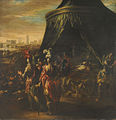Giovanni Andrea Donducci
Giovanni Andrea Donducci ( February 14, 1575 in Bologna - 1655 there ), also known as Mastellétta , was an Italian baroque painter of the Bolognese school and engraver . He completed his training at the Accademia degli Incamminati .
Life
His father Andrea made vats, mastelli . Hence the name under which it became known. His mother was called Paola. He completed his studies with the Incamminati at a time when Domenichino , Lucio Massari and probably also Francesco Albani were teaching there. During a stay in Rome he is said to have met Agostino Tassi and his works. The painter biographer Carlo Cesare Malvasia writes that the two were friends. He later worked mainly in his hometown of Bologna.
He belonged to the generation of painters who were inspired by and trained by the Carraccis , such as Giacomo Cavedone (1577–1660), Lorenzo Garbieri (1580–1654), Lionello Spada (1576–1622) and Alessandro Tiarini (1577–1668) ). He developed his own original style, which combined elements of Roman classicism with the fantastic lighting effects, as they were common in the tradition of Ferrara and Venice.
In the years 1613 and 1614 he was with orders for the Basilica of San Domenico worked in Bologna. He was responsible for furnishing the chapel of St. Dominic. In 1613 he painted The Miracle of the Forty Drowning Men for the right side of the chapel , and in 1614 for the left side the resurrection of the young Napoleone Orsini . For the hanging spandrels of the dome of this basilica, he designed frescoes dedicated to the patron saints of the city of Bologna, St. Florian , St. Francis , St. Proculus and St. Petronius .

For San Paolo Maggiore he created two large-format wall paintings, a Cristo all'orto and a station of the cross. Important works can be found in museums in Bologna, Rome, Munich and Buenos Aires.
Malvasia describes him in the late 1620s as increasingly withdrawn and neurotic - "an enemy of his friends, in other words suspicious, self-hating." His characters have an almost phantasmagoric ardor, as we know from the later Alessandro Magnasco , the is not at all characteristic of the Bolognese school. He also integrated lavishly painted, detailed landscapes in his paintings, probably influenced by Scarsellino or Nicolò dell'Abbate .
His last known work is the altarpiece Madonna del Giglio from 1639 for San Pietro (Reggio Emilia) .
Important works
- Moses in the desert , fresco in the Museo di San Domenico (Bologna)
- Mystical marriage of St. Katherina , Galleria Spada , Rome
- Miracle of St. Dominic , Basilica di San Domenico (Bologna)
- Handing over the key to St. Petrus , Basilica di San Domenico, Bologna
- Resurrection of Christ , 1623-25
- Life of the Baptist , chiesa dei Servi, 1635
- Jesus served by angels , Pinacoteca Nazionale di Bologna
- Rest on the flight into Egypt , Pinacoteca Nazionale di Bologna
painting
Annunciation ,
Pinacoteca Nazionale di BolognaLakeside feeding ,
Galleria Nazionale d'Arte Antica , RomeWar scene ,
Museo Nacional de Bellas Artes , Buenos Aires
literature
- Francis P. Smyth and John P. O'Neill (Editors in Chief): National Gallery of Art, Washington DC (Eds.): The Age of Correggio and the Carracci: Emilian Painting of the 16th and 17th Centuries 1986, p. 495 -501.
- Rudolf Wittkower : Art and Architecture Italy, 1600-1750 . In: Pelican History of Art , 1980, Penguin Books Ltd, 1993, pp. 92-95.
Individual evidence
- ↑ a b Beni culturali: Opere del Mastelletta nella Pinacoteca di Bologna , accessed on August 18, 2018
Web links
- Fondazione Federico Zeri: Donducci Giovanni Andrea
| personal data | |
|---|---|
| SURNAME | Donducci, Giovanni Andrea |
| ALTERNATIVE NAMES | Mastelletta |
| BRIEF DESCRIPTION | Italian painter and engraver of the Baroque |
| DATE OF BIRTH | February 14, 1575 |
| PLACE OF BIRTH | Bologna |
| DATE OF DEATH | 1655 |
| Place of death | Bologna |





